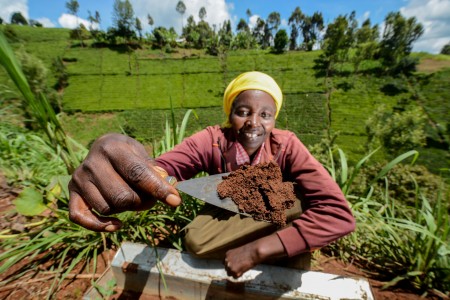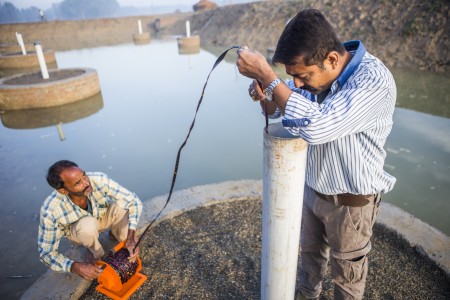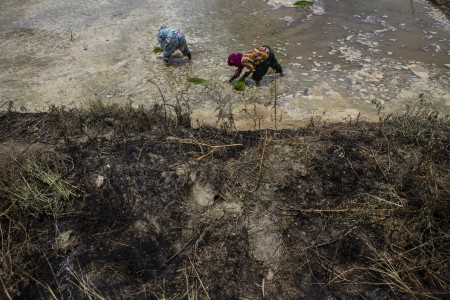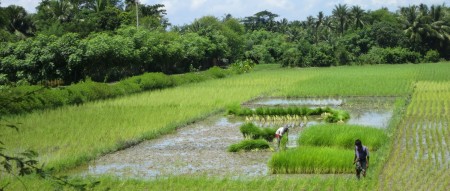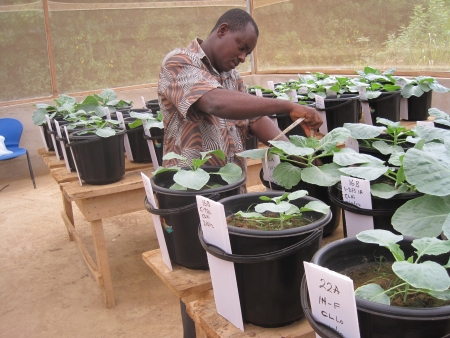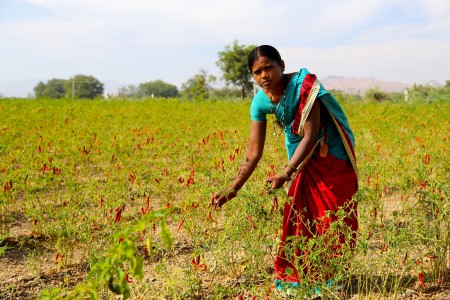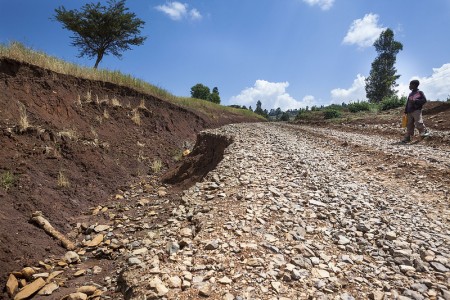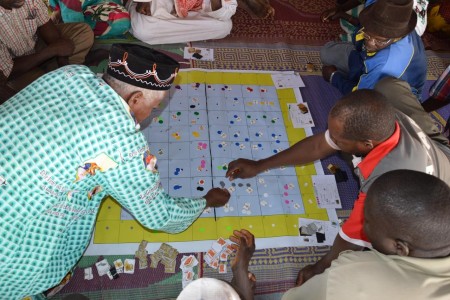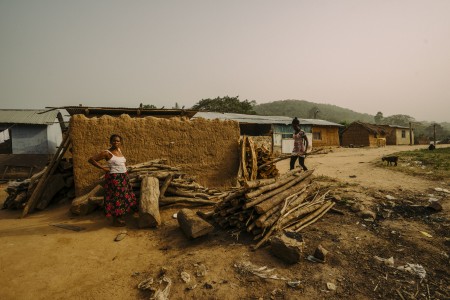The WLE 2016 Annual Report > Influencing policy and decision making

A community-managed approach to improving agricultural productivity in the Ganges delta
Rural communities in Southern Bangladesh have been benefiting from a pilot project established to explore low-cost, community-based solutions to combat the effects of flooding, saline water intrusion and monsoon rains that destroy crops. WLE has been piloting new ways to collectively manage water in these areas to increase both agricultural and aquaculture productivity. The pilot, led by the International Rice Research Institute (IRRI), is exhibiting strong improvements in productivity, rural incomes and family nutrition.
WLE researchers worked in the polders of the coastal zone of Bangladesh. A polder is infrastructure that helps control tidal flooding, including embankments and sluice gates, that enables one or two crop seasons a year in hostile coastal environments. Over eight million people depend on the land within the polders for their food security and livelihoods. 139 of these polders were constructed in Bangladesh during the 1960s and '70s with the aim of boosting the productivity of over a million hectares of low-lying farmland.
Unfortunately, rural communities living in these areas of the Ganges delta experience much lower levels of agricultural productivity than elsewhere in the country, resulting in widespread poverty and food insecurity. They are also highly vulnerable to climate risk and variability.
Partnerships for increased productivity
Despite widespread assumptions that saline intrusion was to blame for low productivity on these farms, WLE research found that the main cause was poor drainage. In response, researchers in partnership with Blue Gold, a collaborative program between the Governments of the Netherlands and Bangladesh, pilot tested two strategies to improve agricultural productivity in four villages in a 30ha polder. Local communities, NGOs and local government were also deeply engaged in the research and pilot testing.
WLE examined the potential use of early maturing, high yielding rice varieties as a first crop, followed by a dry season of maize or sunflower crop, grown and harvested before the monsoon rains. The window between harvest of the first crop and arrival of the monsoon rains is short so second dry season crops had previously been at risk of getting destroyed by the arrival of rains before they were ready to harvest.
In addition, researchers looked at the impacts of revitalizing water infrastructure and its management. WLE pilot tested an improved community-managed drainage system that involved the repair of existing culverts (drainage pipes), digging new drainage channels and de-silting the original drainage system. Members of the community water management organization were trained and mentored to enable systematic sluice gate operation at low tide. The community-managed drainage system greatly reduced the risk of water logging in farmer's fields, brought about by frequent heavy rainfall taking place even before the monsoon.
Early results, unexpected wins and further action
The new, high-yielding rice varieties enabled a jump in yield from around 2-3 tonnes per hectare to 4-5.5 tonnes per hectare. The next step is to match this raised productivity with improvements in the agricultural marketing chain to make sure that returns can be maximised.
Augmenting rice production in the wet season by integrating aquaculture was also found to play an important role in diversifying and improving the incomes of polder communities. WLE research showed that collective fish culture, within a well-defined Water Management Unit, can produce significantly more fish than can be harvested from naturally occurring stock in the rice fields. Improved household nutrition and the profitability of this aquaculture for both women and men are already providing good incentives, but some types of fish (such as carp) also feed on rice weeds. This reduces the need for, and cost of, regular weeding.
Indications from WLE research show that there could also be potential for other new income-generating activities connected to the three interventions examined in the pilot project. For example, women (whose ability to find employment and other livelihood generating activities is often restricted by traditional social norms in Bangladesh) and youth may find new employment possibilities through the adoption of rice transplanting machines or preparing rice mat nurseries. Equally, if dry season sunflower production is successfully expanded, this opens up avenues to produce and market sunflower oil.
Lessons from the success of these pilots in Bangladesh are now informing WLE work on improving the productivity of flood-based farming sites in Sudan and Ethiopia. Other similar opportunities to have an impact are also emerging in the Mekong Delta.
Learn more about WLE's research on enhancing smallholders' livelihoods.
Towards sustainable intensification:
stories of real-world sciencewater, land and ecosystems research highlights
Phase 1
Since its inception in 2012, the CGIAR Research Program on Water, Land and Ecosystem (WLE) has developed scientific evidence and solutions for sustainably intensifying agriculture.
For WLE, sustainable intensification means more than minimizing agriculture’s environmental footprint; it means making sure that agriculture benefits both the planet and its people, providing global populations with food and nutritional security, resilience and livelihoods.
WLE researchers and their partners work across scales, disciplines and sectors to find sustainable, viable ways to transform agriculture, locally and at scale. Discover how the resulting solutions can lead to real-world change by exploring the briefs and stories below to.
New briefs on sustainable intensification
Achieving resilient food systems requires identifying incentives for sustainable farming, developing new policies and institutions, as well as working with diverse stakeholders to test and scale integrated solutions.
The program’s findings so far are summarized in a new series of briefs, Towards sustainable intensification: Insights and solutions.
The series aims to guide and support decision and policy makers, investors and others working to achieve sustainable intensification of agriculture. Each brief is focused on a topic of strategic relevance and provides analysis of and recommendations on how to place sustainability at the heart of agri-food systems.
in 2015 wle: field tested 62 technologies and natural resource management practices, helped 125,000 farmers to apply new technologies or management practices, supported improved technologies or management practices on 2.5 million hectares
Influencing policy and decision making
In 2015 WLE: established 41 multi-stakeholder platforms and influenced 200 policy processes
Promoting innovative business models and institutions
Facilitating community-led science
WLE in 2015 had 110,000 website visits and 43,000 views on CG-space and published 141 ISI publications and 94 open access publications




